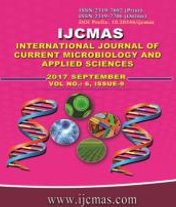


 National Academy of Agricultural Sciences (NAAS)
National Academy of Agricultural Sciences (NAAS)

|
PRINT ISSN : 2319-7692
Online ISSN : 2319-7706 Issues : 12 per year Publisher : Excellent Publishers Email : editorijcmas@gmail.com / submit@ijcmas.com Editor-in-chief: Dr.M.Prakash Index Copernicus ICV 2018: 95.39 NAAS RATING 2020: 5.38 |
The present investigation was conducted at Plant Breeding Farm, Department of Genetics and Plant Breeding, Faculty of Agriculture, Annamalai University during 2015 – 2017. The experiment was carried out to explore the extent of divergence in 48 rice genotypes for nine characters. In D2 analysis, the 48 genotypes were grouped into nine clusters. The clustering pattern indicated that there was no parallelism between genetic diversity and geographical origin as the genotypes from different origins were included in same clusters and vice versa. The maximum intra cluster distance was registered in cluster VIII (35.87). The maximum inter cluster distance was found between Cluster VI and Cluster VIII (54.23) followed by Cluster VIII and IX (51.01), cluster V and VIII (50.26) and cluster III and VIII (45.60). Genetically distant parents from those clusters could be able to produce higher heterosis in progenies on hybridization. Grain yield per plant and thousand grain weight were the major contributors towards the total genetic divergence among the genotypes studied. Selection could be made based on grain yield per plant and thousand grain weight for the progenies identified.
 |
 |
 |
 |
 |